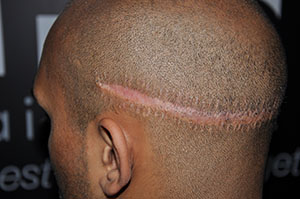Treating a balding condition can be a straightforward effort or it could turn out to become a creative endeavor. There is more than one way to treat hair loss and it really depends on how anyone would like to approach it. One method can be used or it can be combined with others. Prior diagnosis on the type of balding should however be accomplished before beginning treatment. Not all manifestations are the same and there are also different stages for certain kinds of hair loss such as male pattern baldness.

Androgenic alopecia initially begins in the temporal areas of the scalp. It recedes toward the back of the head forming an M-shaped pattern when viewed from the top. The frontal region over the forehead will also display thinning before slowly exposing a larger balding area. Simultaneous hair loss can also be exhibited by the vertex area beginning at its center. This will gradually increase in circumference until it coincides with the balding that began at the hairline. It will cause hair loss over the top of the scalp though the areas at the lower sides and back of the head will still retain active hair follicles. This region will still produce hair growth even in the latter phases of male pattern baldness. It is also considered as the donor area for the purposes of hair transplant surgery.
Harvesting healthy hair follicles from one location of the scalp and transplanting them to another is a procedure that many have benefitted from. It is true that no new hair follicles are created through hair transplant surgery. They are merely repositioned. It is the skill level and experience of the surgeon that will dictate how well this is distributed throughout the scalp. His expertise will also influence how unblemished the donor area can appear after extracting hair follicles from it.
Follicular unit transplantation or FUT is one of the methods in hair transplant surgery. This is often utilized for large volume extraction of hair follicles by making a horizontal incision on the back of a patient’s scalp. It is taken from what is regarded as the donor area. A strip of skin measuring about twenty centimeters long holds the hair strands to be transplanted. This will be divided into smaller grafts containing anywhere between one to six healthy hair follicles. It can materially increase the density of a patient’s hair once the scalp has recovered. The consistent side effect of this technique however is the long linear scar that will result from where the strip of skin was extracted.
Scalp micropigmentation is a highly dynamic procedure that is applicable upon any balding condition. It can also be used on scarring as a result of hair transplant surgery or any markings as a result of trauma to the head. FUT scars can be effectively camouflaged by this treatment. It not only needs to cover the exposed area but a few inches surrounding it as well. Some patients choose to have their entire scalp layered with pigments in case their hair loss continues beyond the treated area. All they would have to do is to shave off their existing hair to reveal the scalp micropigmentation underneath.
A natural looking hair loss remedy is always the end goal of any technique used. It is best when other people do not even realize that a patient’s scalp has received treatment. This classifies it as a success and using more than one method is a welcome addition to ensure that this will happen. FUT scars might be very noticeable when the patient begins to lose more hair beyond what he thought would constitute his donor area. The same can apply when he simply wants to wear his hair shorter. Fortunately, scalp micropigmentation is available to address this situation should it arise.
SHARE

